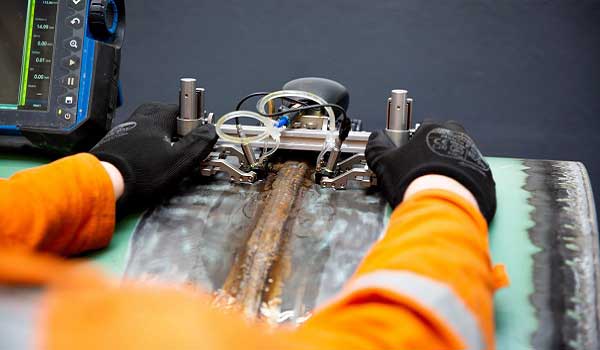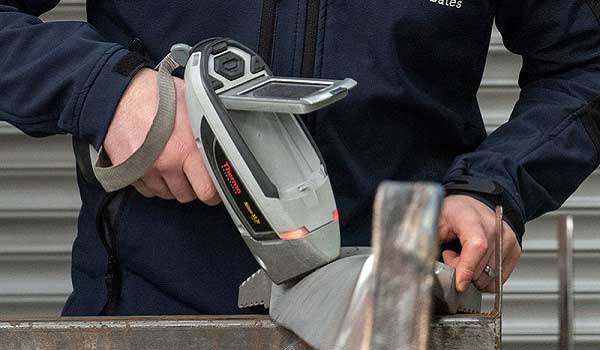Dye Penetrant Inspection
What is Dye Penetrant Inspection?
Dye Penetrant Inspection (DPI), also called Liquid Penetrant Inspection (LPI) or Penetrant Testing (PT), is one of the oldest and simplists NDT methods where its earliest versions (using kerosene and oil mixture) dates back to the 19th century.
Liquid penetrant inspection is used to detect any surface-connected discontinuities such as cracks from fatigue, quenching, and grinding, as well as fractures, porosity, incomplete fusion, and flaws in joints.
Principles
DPI is based upon capillary action, where low surface tension fluid penetrates into clean and dry surface-breaking discontinuities. Penetrant may be applied to the test component by dipping, spraying, or brushing. After adequate penetration time has been allowed, the excess penetrant is removed, a developer is applied. The developer helps to draw penetrant out of the flaw where an invisible indication becomes visible to the inspector. Inspection is performed under ultraviolet or white light, depending upon the type of dye used - fluorescent or nonfluorescent (visible).
Materials
Penetrants are classified into sensitivity levels. Visible penetrants are typically red in color, and represent the lowest sensitivity. Fluorescent penetrants contain two or more dyes that fluoresce when excited by ultraviolet (UV-A) radiation (also known as black light). Since Fluorescent penetrant inspection is performed in a darkened environment, and the excited dyes emit brilliant yellow-green light that contrasts strongly against the dark background, this material is more sensitive to defects.
When selecting a sensitivity level one must consider many factors, including the environment under which the test will be performed, the surface finish of the specimen, and the size of defects sought. One must also assure that the test chemicals are compatible with the sample so that the examination will not cause permanent staining, or degradiation. This technique can be quite portable, because in its simplest form the inspection requires only 3 aerosol spray cans, some lint free cloths, and adequate visible light. Stationary systems with dedicated application, wash, and development stations, are more costly and complicated, but result in better sensitivity and higher samples through-put.

Red Dye Penetrant applied

Excess Penetrant removal

White Developer applied
Inspection steps
- Pre-cleaning..
The test surface is cleaned to remove any dirt, paint, oil, grease or any loose scale that could either keep penetrant out of a defect, or cause irrelevant or false indications. Cleaning methods may include solvents, alkaline cleaning steps, vapor °reasing, or media blasting. The end goal of this step is a clean surface where any defects present are open to the surface, dry, and free of contamination. Note that if media blasting is used, it may "work over" small discontinuities in the part, and an etching bath is recommended as a post-blasting treatment.
- Application of Penetrant..
The penetrant is then applied to the surface of the item being tested. The penetrant is allowed "dwell time" to soak into any flaws (generally 5 to 30 minutes). The dwell time mainly depends upon the penetrant being used, material being tested and the size of flaws sought. As expected, smaller flaws require a longer penetration time. Due to their incompatible nature one must be careful not to apply solvent-based penetrant to a surface which is to be inspected with a water-washable penetrant.
- Excess Penetrant Removal..
The excess penetrant is then removed from the surface. The removal method is controlled by the type of penetrant used. Water-washable, solvent-removable, lipophilic post-emulsifiable, or hydrophilic post-emulsifiable are the common choices. Emulsifiers represent the highest sensitivity level, and chemically interact with the oily penetrant to make it removable with a water spray. When using solvent remover and lint-free cloth it is important to not spray the solvent on the test surface directly, because this can remove the penetrant from the flaws. If excess penetrant is not properly removed, once the developer is applied, it may leave a background in the developed area that can mask indications or defects. In addition, this may also produce false indications severely hindering your ability to do a proper inspection.
- Application of Developer..
After excess penetrant has been removed a white developer is applied to the sample. Several developer types are available, including.. non-aqueous wet developer, dry powder, water suspendable, and water soluble. Choice of developer is governed by penetrant compatibility (one can't use water-soluble or suspendable developer with water-washable penetrant), and by inspection conditions. When using non-aqueous wet developer (NAWD) or dry powder, the sample must be dried prior to application, while soluble and suspendable developers are applied with the part still wet from the previous step. NAWD is commercially available in aerosol spray cans, and may employ acetone, isopropyl alcohol, or a propellant that is a combination of the two. Developer should form a semi-transparent, even coating on the surface.
The developer draws penetrant from defects out onto the surface to form a visible indication, commonly known as bleed-out. Any areas that bleed-out can indicate the location, orientation and possible types of defects on the surface. Interpreting the results and characterizing defects from the indications found may require some training and/or experience.
- Inspection..
The inspector will use visible light with adequate intensity (100 foot-candles or 1100 lux is typical) for visible dye penetrant. Ultraviolet (UV-A) radiation of adequate intensity (1,000 micro-watts per centimeter squared is common), along with low ambient light levels (less than 2 foot-candles) for fluorescent penetrant examinations. Inspection of the test surface should take place after 10 to 30 minute development time, depends of product kind. This time delay allows the blotting action to occur. The inspector may observe the sample for indication formation when using visible dye. It is also good practice to observe indications as they form because the characteristics of the bleed out are a significant part of interpretation characterization of flaws.
- Post Cleaning..
The test surface is often cleaned after inspection and recording of defects, especially if post-inspection coating processes are scheduled.

Advantages and Disadvantages
The primary advantages and Disadvantages when compared to other NDT methods are..
Advantages
- High sensitivity (small discontinuities can be detected).
- Few material limitations (metallic and nonmetallic, magnetic and nonmagnetic, and conductive and nonconductive materials may be inspected).
- Rapid inspection of large areas and volumes.
- Suitable for parts with complex shapes.
- Indications are produced directly on the surface of the part and constitute a visual representation of the flaw.
- Portable (materials are available in aerosol spray cans)
- Low cost (materials and associated equipment are relatively inexpensive)
Disadvantages
- Only surface breaking defects can be detected.
- Only materials with a relatively nonporous surface can be inspected.
- Pre-cleaning is critical since contaminants can mask defects.
- Metal smearing from machining, grinding, and grit or vapor blasting must be removed.
- The inspector must have direct access to the surface being inspected.
- Surface finish and roughness can affect inspection sensitivity.
- Multiple process operations must be performed and controlled.
- Post cleaning of acceptable parts or materials is required.
- Chemical handling and proper disposal is required.
Standards
International Organization for Standardization (ISO)
- ISO 3452-1, Non-destructive testing - Penetrant testing - Part 1. General principles
- ISO 3452-2, Non-destructive testing - Penetrant testing - Part 2.. Testing of penetrant materials
- ISO 3452-3, Non-destructive testing - Penetrant testing - Part 3.. Reference test blocks
- ISO 3452-4, Non-destructive testing - Penetrant testing - Part 4.. Equipment
- ISO 3452-5, Non-destructive testing - Penetrant testing - Part 5.. Penetrant testing at temperatures higher than 50°C
- ISO 3452-6, Non-destructive testing - Penetrant testing - Part 6.. Penetrant testing at temperatures lower than 10°C
- ISO 3059, Non-destructive testing - Penetrant testing and magnetic particle testing - Viewing conditions
- ISO 12706, Non-destructive testing - Penetrant testing - Vocabulary
- ISO 23277, Non-destructive testing of welds - Penetrant testing of welds - Acceptance levels
European Committee for Standardization (CEN)
- EN 1371-1, Founding - Liquid penetrant inspection - Part 1.. Sand, gravity die and low pressure die castings
- EN 1371-2, Founding - Liquid penetrant inspection - Part 2.. Investment castings
- EN 10228-2, Non-destructive testing of steel forgings - Part 2.. Penetrant testing
- EN 10246-11, Non-destructive testing of steel tubes - Part 11.. Liquid penetrant testing of seamless and welded steel tubes for the detection of surface imperfections
American Society for Testing and Materials (ASTM)
- ASTM E 165, Standard Practice for Liquid Penetrant Examination for General Industry
- ASTM E 1417, Standard Practice for Liquid Penetrant Testing
American Society of Mechanical Engineers (ASME)
- ASME Boiler and Pressure Vessel Code, Section V, Art. 6, Liquid Penetrant Examination
- ASME Boiler and Pressure Vessel Code, Section V, Art. 24 Standard Test Method for Liquid Penetrant Examination SE-165 (identical with ASTM E-165)
Related Post(s)

Time of flight diffraction is a reliable method of ultrasonic testing that is a highly sensitive and accurate method for non-destructive...

Positive Material Identification is one of the more specialised non destructive testing methods by which the alloy composition of materials...